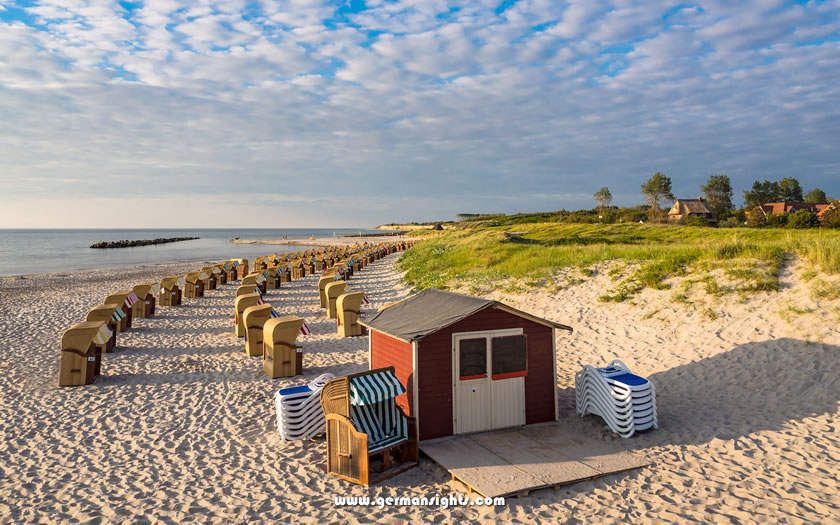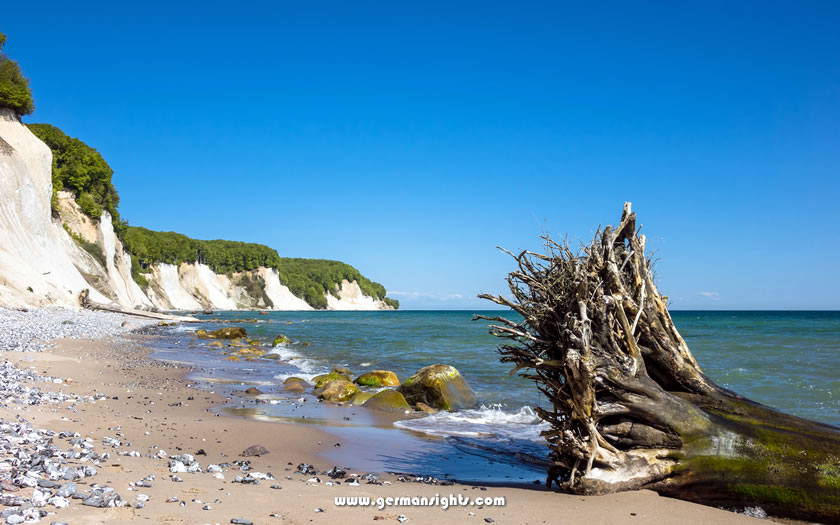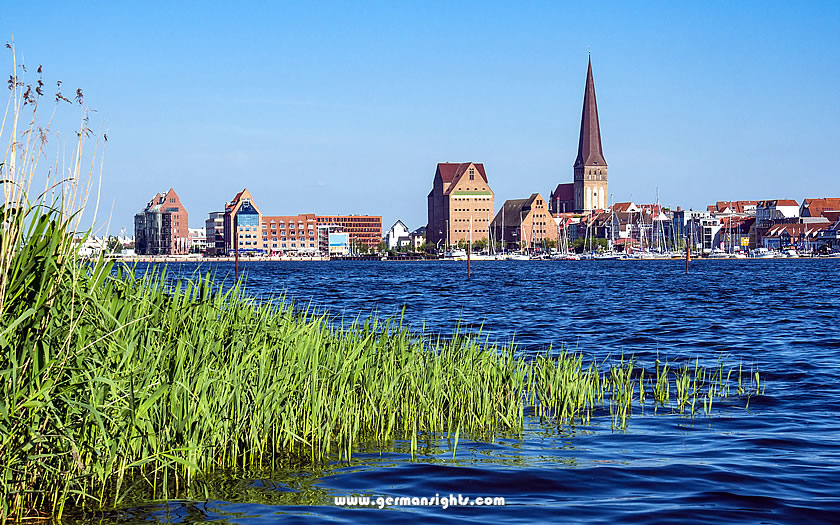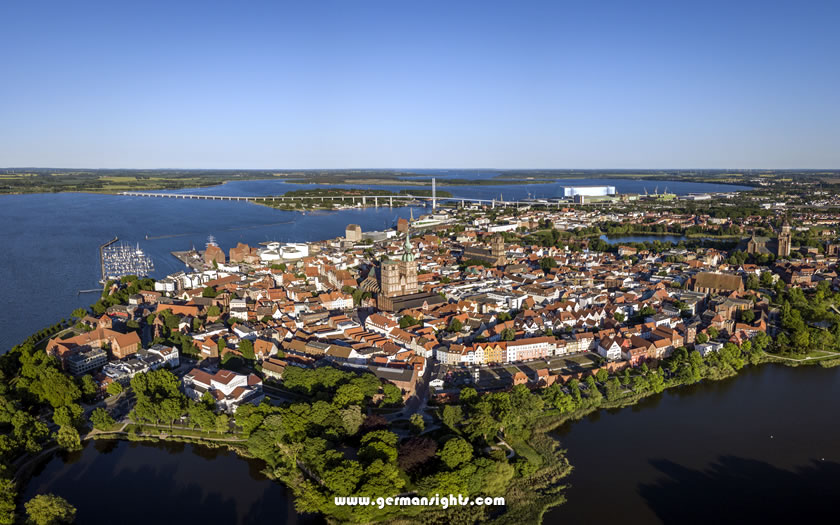Mecklenburg-Vorpommern - also known as Mecklenburg-Western Pomerania - offers quiet Baltic beaches, small historic towns and vast nature reserves without the crowds. This region in the north-east of Germany isn't fast-paced or flashy. Instead, you'll experience relaxed coastal life and scenic countryside.

Relaxation in the Mecklenburg Lake District
Fishing villages, medieval brick churches and ancient castles dot the landscape. If you're into the great outdoors, there are plenty of paths for walking and cycling, and lakes for swimming and boating.
Life here is slower than in the big German cities. Sure, you'll find fewer big events or shopping malls, but you'll have far more opportunities to connect with local culture and nature.
Mecklenburg-Western Pomerania lies in the north-eastern corner of Germany. It hugs the Baltic Sea coast, with Denmark and Sweden across the water.
The state borders Schleswig-Holstein to the west, Brandenburg to the south and a small part of Lower Saxony. It shares its eastern border with Poland. Most of the country is flat, with many lakes, meadows and sandy beaches.

Beach chairs on the Baltic Sea coast
You won't find many hills, but forests cover much of the region. The Baltic coast stretches for about 2,000 kilometres, dotted with islands such as Rügen, Usedom and Hiddensee.
These islands are easily accessible by ferry. Major rivers include the Peene, the Warnow and the Oder on the Polish border. Lakes such as the Müritz attract boaters and anglers.
Distances between towns can be quite long. Public transport doesn't reach every village, so you may want to hire a car if you're heading out into the countryside.
Find out more details on our Mecklenburg-Vorpommern travel information page
Mecklenburg-Western Pomerania as we know it today was created after the Second World War, but its roots go back much further. The region was originally home to Slavic tribes until German settlers arrived in the 12th century. Two distinct areas developed: Mecklenburg in the west and Vorpommern in the east.
The powerful Duchy of Mecklenburg emerged in the Middle Ages, ruled by a dynasty that lasted until 1918. They built impressive residences such as Schwerin Castle.

Basedow castle in the Mecklenburg Lake District
Pomerania, meanwhile, was often caught between Swedish and Prussian interests. The Swedes controlled much of the area from the 1600s until 1815, when Prussia took over.
Both regions became states in the Weimar Republic after Germany's defeat in World War I. The Nazi period brought significant changes, with many Jewish residents forced to flee or facing deportation. The region was heavily bombed during World War II, especially the city of Rostock.
The post-war period saw massive changes. The Soviet army arrived in 1945, bringing with it a wave of refugees from former German territories in the east. The regions were united into one state in the Soviet occupation zone, later becoming part of East Germany (GDR).
The region became known for agriculture, shipbuilding, and seaside tourism for East German citizens under communist rule. In 1990, following German reunification, Mecklenburg-Western Pomerania became one of the five new federal states.
Since then, the region has faced challenges such as high unemployment and population loss, but has developed a strong tourism sector and modernised its agricultural and maritime industries.
Mecklenburg-Vorpommern has peaceful beaches, an extensive lake district and unique national parks. You'll find both tranquil nature spots and lively coastal resorts.
The Baltic Sea coast offers sandy beaches, cliffs and small fishing villages. Popular resorts include Warnemünde, Kühlungsborn and Usedom.
Family-friendly beaches offer shallow waters perfect for children. Seaside promenades make it easy to walk or cycle along the water's edge, and wooden piers are ideal for fishing or taking photographs.
Beaches can get crowded in July and August, especially near larger towns. Dogs are allowed on some sections, especially outside the high season.
Traditional wicker beach chairs can be hired for shelter from the sun and wind. There's more space out of season, but the water remains chilly most of the year.
The Mecklenburg Lake District is one of the largest inland lake regions in Germany. Hundreds of lakes are connected by rivers and canals, the largest being Lake Müritz.

View of Robel on Lake Müritz
The area is perfect for canoeing, boating and bird watching. Towns such as Waren and Plau am See offer easy boat hire.
Anglers come to fish for pike and perch. Footpaths and cycleways link villages and lakeshores. Summer brings more visitors, but many quiet lakes remain.
Some lakes aren't suitable for swimming in late summer because of algae. Insects can be a nuisance near the water, so bring repellent.
The region has three major national parks: Jasmund, Müritz and Vorpommersche Boddenlandschaft ('Western Pomerania Lagoon Area'). Each park protects wildlife and landscapes.
Jasmund has famous chalk cliffs and ancient beech forests, with trails that offer sea views. The Müritz National Park has extensive forests and wetlands, home to cranes, eagles and otters.
The Western Pomerania Lagoon Area protects salt marshes and mudflats that attract migratory birds. Facilities are basic in remote areas, but visitor centres provide maps and information.
Rügen is Germany's largest island, north-east of Stralsund. You can get there by causeway or ferry. The island's white chalk cliffs in Jasmund National Park are iconic, and long beaches and resorts such as Binz and Sellin draw crowds.

White cliffs on Rügen island
Historic railways, such as the Rasender Roland, link towns and offer scenic journeys. Cycling is popular, with flat routes through forests, meadows and along the coast.
The weather on Rügen is cooler and windier than inland, which may change your plans. The main resorts attract large numbers of tourists in the summer.
Schwerin is Germany's smallest state capital, and is known for its lakes and castle. Schwerin Castle is situated on an island surrounded by water and gardens.

Aerial view of Schwerin castle
The city centre has half-timbered houses and a tall brick cathedral. Museums focus on art and local history. Shopping isn't extensive, but there are cafes, bakeries and a few shops.
Public transport works well - buses and trams serve most of the attractions. There are fewer international restaurants and the locals speak some English, but it helps to know a little German.
Rostock is the biggest city in the region, with a large port and a busy railway station. The University of Rostock brings in students to keep the city lively.

View across the Warnow river to Rostock
Kröpeliner Strasse is the main shopping street, lined with Gothic churches and merchants' houses. The Warnemünde beach area is just a short train ride away.
The harbour hosts festivals such as the Hanse Sail, which attracts summer crowds. Rostock offers a range of hotels and guesthouses, and public buses and trams link the city's districts to the sea.
Stralsund lies on the Baltic coast and is the gateway to the island of Rügen. Its brick Gothic architecture has earned it UNESCO World Heritage status.

Aerial view of Stralsund and the bridge to Rügen island
The old town is compact and easy to explore on foot. The main attractions include the Ozeaneum aquarium, the historic town hall and the churches with their high steeples.
Wismar is another UNESCO site, known for its Hanseatic past and large market square. Many buildings date back to the Middle Ages and the town is best seen on foot.

The old port at Wismar
Take a look at St Nicholas Church, the old town hall and the alleys lined with merchants' houses. The old harbour is now used by pleasure craft, and you can buy fish snacks straight from the local boats.
Mecklenburg-Vorpommern’s cities once traded across the Baltic Sea, leaving behind some unique architecture and traditions.
In towns like Rostock, Wismar, and Stralsund, the Hanseatic League shaped daily life from the 13th to 17th centuries. You can walk cobbled streets lined with old storehouses and merchant homes.
These cities joined a powerful trade network that reached Sweden, Russia, and England. Museums like the Stralsund Museum explain how sea trade shaped the region.
Old city gates and walls show how residents protected markets and ships. Many buildings carry the UNESCO title for their history.
Seasonal markets and Hanse Sail events bring traditions to life. You’ll see tall ships in the harbor or taste smoked fish straight from the boats.

Vessels at the Hanse Sail maritime festival in Rostock
Red-brick Gothic buildings stand out everywhere. Builders used local clay—stone is rare here—to make churches and warehouses.
St Mary’s Church in Rostock and St Nicholas’ in Wismar are key sites. Their pointed arches, stepped gables, and tall towers catch the light in all weather.

View over the town of Wismar
Many buildings were rebuilt after WWII. Restoration is ongoing, so you might see scaffolding. Entry to churches is often free, but bell towers may require a ticket.
Small villages like Vitt, Ahrenshoop, and Wieck keep fishing traditions alive. Watch wooden boats launch at sunrise or check out old cottages with thatched roofs and blue doors.
Harbors fill with herring nets and crab traps. Meals are simple—fried herring, whitefish, or cod. The pace is slow and quiet, and some towns have limited shops in winter.
Artists move here for the peaceful landscape. Some areas cater to tourists, but most villages are still working communities. Respect private property as you explore.
Regional dishes rely on basics like potatoes, fresh fish, and cabbage. You’ll find Brathering (fried marinated herring), Räucheraal (smoked eel), and Sanddorn (sea buckthorn) jams in village shops.
Guesthouses often serve “Mecklenburger Rippenbraten”—roast pork with prunes and apples—in autumn. Bakeries sell rye breads and Schrippen rolls. Cafés usually offer Rote Grütze, a fruit pudding with cream or ice cream.
Local food is rustic, and fine dining is rare. Some coastal towns have just one pub or fish shack. Markets sell local cheese, honey, and sausages on weekends and at festivals.
You’ve got many ways to spend your time here. The region blends outdoor adventures with relaxing therapies, and you can easily switch between water and land activities.
With over 2,000 lakes and the Baltic Sea coast, you can try canoeing, sailing, windsurfing, or paddleboarding. Most lakes are calm and beginner-friendly.
Rental stations at Müritz, Plauer See, and Lake Schwerin provide equipment and safety tips. Sailing clubs welcome visitors for day lessons.
On the Baltic Sea, you can book a spot on a traditional wooden yacht. Boats often leave from Rostock or Stralsund, sometimes stopping at small islands.
Guided group boat tours are available along lagoons and bays. Water stays cool, except in summer, and wetsuits are available for rent.
July and August get busy, but outside those months, you’ll enjoy quieter waters, though fewer rental shops may be open.
Cycling is a great way to see the countryside. Over 2,000 km of marked trails cross forests, farmland, and the coast.
The Baltic Sea Cycle Route hugs the shoreline, passing fishing villages, lighthouses, and cliffs. The Ice Age Route shows off glacial landscapes.

Cycling to the beach on Rügen island
Bikes are easy to rent in towns like Waren, Güstrow, and Greifswald. If you bring your own, local trains often allow bikes, but check in advance.
Flat coastal terrain suits most people, but inland areas have some hills. Wind and rain can show up in spring and autumn, so pack waterproofs.
Wild camping is not allowed, but campgrounds are near main routes. Some trails go through remote areas, so carry water and snacks.
The Baltic coast has long stretches of white sand, especially on Rügen and Usedom. Public beaches have dunes and lifeguards in summer.
You can swim, play volleyball, or rent a Strandkorb ('beach chair') for the day. Family areas offer shallow water and gentle waves.
Dogs aren’t allowed on main beaches during peak season, but some dog-friendly spots are marked. Water warms up from late June to early September.
Many towns are spa resorts (Kurorte). You can book massages, seawater treatments, or mud baths. Wellness hotels in Binz, Heringsdorf, and Kühlungsborn offer day passes for non-guests.
Facilities usually include saunas, pools, and therapy rooms. Local chalk from Rügen is used in some treatments. Advance booking is smart, especially in high season.
Prices are usually lower than in big cities. Some spas don’t allow children or have age limits for saunas. Nudity in saunas is normal, so don’t be surprised.